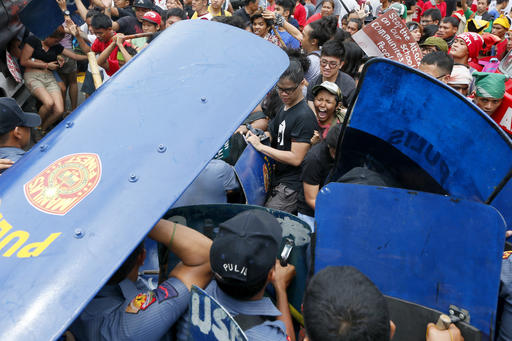
Police and protesters clash during a violent protest outside the U.S. Embassy in Manila, Philippines, Wednesday, Oct. 19, 2016. A Philippine police van rammed into protesters, leaving several bloodied, as an anti-U.S. rally turned violent Wednesday at the embassy in Manila. AP
MANILA, Philippines — A van from the Manila Police District (MPD) rammed into protesters, leaving several bloodied, as an anti-US rally turned violent Wednesday at the American Embassy on Roxas Boulevard in Manila.
The van’s driver, Police Officer 3 Franklin Kho, told reporters he did not deliberately hit the protesters but was trying to drive away from them because they were hitting the vehicle with wooden clubs and he feared they would commandeer it and use it to attack other policemen.
“They were already trying to seize the vehicle,” Kho told reporters.
Associated Press TV footage showed the van repeatedly ramming the protesters as it drove wildly back and forth after activists surrounded and started hitting it with the wooden batons they seized from police.
In front of horrified crowds, the van suddenly charged backward then sprinted forward twice over a space of about 20 meters (60 feet), barreling through the scattered protesters and hurtling some to the side like bowling pins. A few were run over but somehow managed to stand.
Some screamed in surprise, others hurled stones at the van and yelled invectives. A speaker called the police “puppies of imperialists” on a loudspeaker.
At least three student activists were taken to a hospital after they were run over by the van, protest leader Renato Reyes said.
“There was absolutely no justification for it,” Reyes said of the violent police dispersal of about 1,000 protesters. “Even as the president vowed an independent foreign policy, Philippine police forces still act as running dogs of the US.”
More than two dozen policemen were injured, police officials said, adding that police observed “maximum tolerance,” but rowdy protesters kept assaulting the law enforcers.
Police lobbed tear gas and arrested at least 29 protesters who broke through a line of riot police and hurled red paint at the officers and a US government seal at the start of the rally at embassy compound beside Manila Bay.
A firetruck doused the rowdy protesters with water to push them back, but they took hold of the water hose and confronted the outnumbered police with rocks and red paint. After breaking through the police corridor, they scribbled “US troops out now” and other slogans at the embassy’s tall fence with red paint.
In a statement, the Philippine National Police (PNP) said that the violent dispersal was “unfortunate” and an investigation would try to determine if the riot policemen followed crowd-control procedures. Investigators will also evaluate criminal and civil liabilities of the protesters and their leader for an alleged illegal mass assembly.
A left-wing legal group, the National Union of People’s Lawyers, condemned the police violence and said it would help the injured and detained protesters file criminal complaints against the police for violating their constitutional rights to free assembly.
The protesters, consisting of students, workers, and tribespeople, were demanding an end to the presence of visiting US troops in the Philippines and to support a call by President Rodrigo Duterte for a foreign policy not dependent on the US, the country’s longtime treaty ally.
The activists came from the largest left-wing umbrella group, Bayan (Nation), which has organized regular anti-US protests in front of the embassy for decades, most of which are peaceful.
Duterte was on a state visit to China, where he is seeking to repair relations strained under his predecessor over territorial conflicts in the South China Sea. He is also seeking to expand trade and investments and financing for badly needed infrastructure projects.
Amid an uneasy relationship with the US, Duterte has tried to reach out to China and Russia, bringing uncertainty to his country’s long alliance with America.
But the protesters also opposed the president’s effort to lean toward China. “The Philippines will not be dictated on, whether by the US or China,” they said in a statement.
The violence happened as the police and Duterte are under increased international scrutiny for their alleged role in the killings of thousands of drug suspects and pushers as part of the president’s war on illegal drugs.